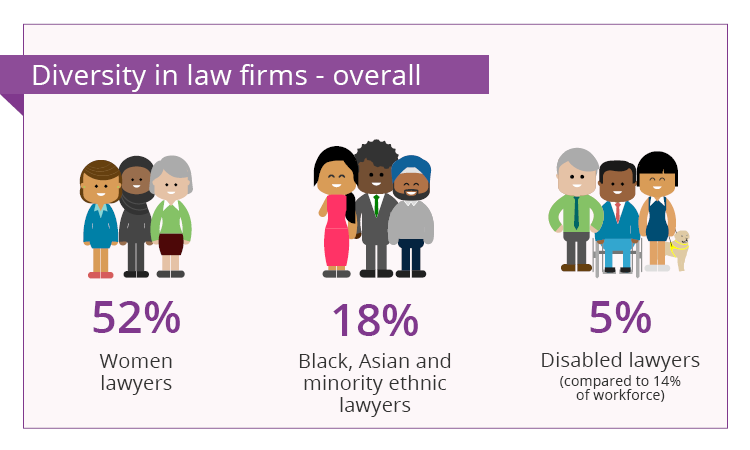Slaughter & May Diversity
==> List your law role on the LawFuel Network
- Slaughter & May diversity aim: By the end of 2027, a minimum of 40% of the firm’s equity partner promotions globally will be women.
- Between May 2020 and April 2025, a minimum of 15% of equity partner promotions in London and Brussels will be from ethnic minority backgrounds.
David Wittmann, Slaughter and May Practice Partner, said: “We need a proportionate diversity mix and to recruit and promote from the widest possible pool of talent. This is vital to the sustained success of the firm.
“The targets are an important signal of our intent to do better; they aim to ensure we are identifying talent and doing what we can to ensure that everyone has the opportunity to succeed at the firm. They will allow us to measure and track progress, and facilitate a dialogue within the firm about the behaviours and processes that can impact the diversity we seek.”
The firm implemented the Slaughter & May diversity gender target internally from 2018 and has since been working to promote a minimum of 40% women to partner level. The number will be tracked in two five year cohorts from 2018 until 2027, with the average number of female partner promotions over the last four years exceeding the target, at 44%.
The firm implemented the ethnic minorities target internally from last year, and 15% of promotions in 2020/21 have been of ethnic minorities into the partnership.
The targets have taken into account gender and ethnicity data from the firm and the wider market, which shows greater disparities in career outcomes for these demographics.
These factors, along with analysis of how the structure, processes and culture at Slaughter and May diversity work, have helped set these targets.
Slaughter and May Head of Responsible Business and Inclusion, Uzma Hamid-Dizier, said: “We recognise that greater transparency about these targets is an important step in achieving them as it’s a sign of commitment. We’re using this opportunity to tell everyone – employees, clients, and the wider market – that this is important to us. We’ve identified a number of actions that we are taking in support of them. They are certainly ambitious but also achievable.
“While the targets work to address the balance of the partnership at junior level, the firm has also taken steps to review representation at more senior levels. For example, in 2018, the partnership undertook an extensive review of how Board roles are filled and as a result from last year, female partners make up five of 11 of the Partnership Board members.”
“The aim of the targets is to retain and promote high quality lawyers, whilst also identifying diverse talent and ensuring the opportunity to succeed at the firm.” says David Wittmann. “We are fully committed as a partnership to achieve these targets.”
LawFuel Update: Law Firm Diversity in the UK –
The overview of diversity in the solicitors’ profession as shown by the UK Solicitors Regulation Authority (SRA) and published in 2023 was collected from law firms in 2021 and updated with later submissions showing as follows:

The survey of diversity in law firms showed a slow but steady increase in diversity among all lawyers since the last survey carried out in 2019. We are including the ‘prefer not to say’ responses in our analysis this year.
Some points noted by the SRA:
- There was an increase in the proportion of women in the profession, and although the seniority gap between female partners and solicitors remains significant, it narrowed slightly.
- There was an increase in the proportion of Black and Asian lawyers, but no change for lawyers from a Mixed/multiple group or Black or Other minority ethnic background. There was a slight decrease for White groups.
- There was an increase in disabled lawyers. However, there is still significant under-representation of disabled lawyers compared to the UK workforce. These were the only two categories where there was a slight increase in those who preferred not to say.
- There is a significant difference in the proportion of lawyers from a ‘privileged’ background compared to the UK population, based on socio-economic background (determined by parental occupation at aged 14) and attendance at independent/fee-paying schools.
The differences by firm size highlights significant differences in diversity for the largest law firms (with 50+ partners), compared to the smallest (with one partner), which demonstrates the challenge faced by many law firms.
Source: SRA, UK
According to recent news articles, UK law firms are making efforts to improve diversity, equity, and inclusion (DEI) within the legal sector.
However, progress remains slow and some firms have failed to meet their diversity targets.
Some firms have launched industry collectives to boost race and ethnic diversity, while others have revised their objectives after reaching their diversity targets ahead of schedule.
For more information, see The UK Legal Diversity Rankings 2022: How the Top Firms Fared, Missed Targets: How Top Law Firms Fail to Hit Their Diversity Goals, Top UK law firms launch industry ‘collective’ to boost race and ethnic diversity, and Diversity in the UK’s legal profession – The Lawyer |
- Organizing the delivery of cars from the USA: from the auction to the client
- UK Law – Richard Reed Law Forge Collaboration With HR Experts
- Foley Expands Tax Capabilities with Addition of Partner David Morris in Salt Lake City
- Legal AI Produces ‘Law Firm 2.0’
- What to Expect When Facing Criminal Allegations
- Legal AI Produces ‘Law Firm 2.0’
- Diamond & Diamond Lawyers Lead L’Oreal Hair Relaxer Class Action in Canada
- NZ Law – Dentons NZ Announce Seven New Partners
- Australian Court Issues Warning on Legal AI Citation Errors in Legal Practice
- Top 6 Questions You Must Ask a Car Accident Lawyer Before You Hire Them in 2025